Understanding the properties of rare-earth doped fibers — core components of amplifiers as well as many laser types — is paramount to obtaining optimal outcomes from engineered systems.
RÜDIGER PASCHOTTA, RP PHOTONICS AG
Industry’s favor for rare-earth doped fibers increased greatly in the last four decades. Erbium (Er)-doped telecom fiber amplifiers, for example, and ytterbium (Yb)- or thulium
(Tm)-doped high-power lasers are widely used for many industrial and
science applications.
Following the development and introduction of these specialty fibers in the 1980s, the adoption of rare-earth doped fibers and the photonic systems that they support did not occur immediately. Yet even as the use of these fibers advanced toward, and ultimately achieved, ubiquity, the fundamental mechanisms behind their performance are largely unchanged.
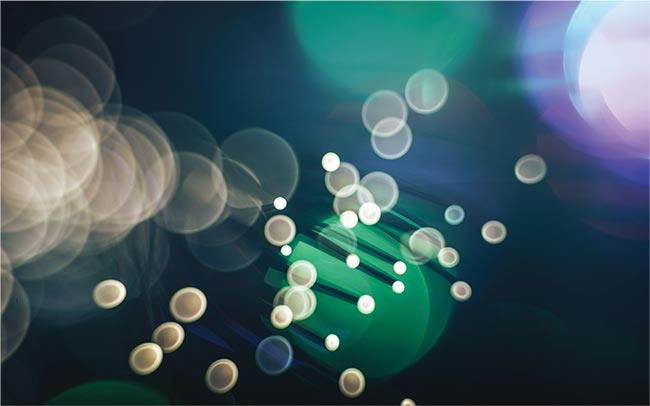
Courtesy of iStock.com/Oleksandr Bushko.
Simply, signal light inside a fiber can be amplified by a collection of excited rare-earth ions. These ions are usually
located only in the core of the fiber and can undergo stimulated emission. Injecting some pump light into one or both ends of the fiber serves to excite the ions.
Except for certain up-conversion pumping schemes, the pump wavelength is shorter than the signal wavelength. When an amplified signal develops substantial optical power, it can influence the ionic excitation. This in turn causes the gain to become saturated.
Strong saturation effects
In many cases, with fiber data obtained from the manufacturer and suitable simulation software, designers and users can reliably predict the performance of rare-earth doped fibers and thus avoid purchasing and testing of fibers that, in the end, may not yield satisfactory results.
In principle, injecting some pump light into a fiber will yield signal amplification. For various reasons, however, it is often difficult to accurately predict what will happen upon the injection of light. For example, Figure 1 shows the resulting profiles of pump power and Yb excitation in the fiber when a Yb-doped single-mode fiber with a core diameter of 4 µm is pumped with 100 mW at 975 nm. Surprisingly, the pump power declines linearly (approximately) rather than exponentially. Also, the power declines on a much longer length scale than one would expect from the absorption coefficient alone. This value is calculated as the product of the Yb density; the absorption cross section; and an overlap factor of the fiber mode with the doped core.
Also, the Yb excitation stays ~50% for much of the propagation length, with little dependence on the local pump power, until it suddenly drops considerably after 3 m of fiber.
The strong saturation of the Yb absorption, related to the substantial degree of Yb excitation, is behind these effects. With only moderate pump power, the
system is well beyond the saturation power, which is as low as 2.4 mW.
Figure 1 also indicates the presence of amplified spontaneous emission (ASE) in both forward and backward directions. The forward ASE is partially reabsorbed in the rest of the fiber. This causes the significant degree of Yb excitation near the right end despite negligible residual pump power.
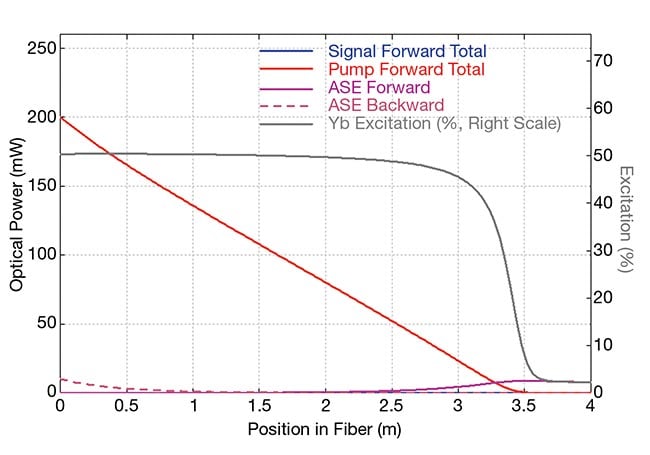
Figure 1. The evolution of optical powers and fractional ytterbium (Yb) excitation in a Yb-doped fiber (gray), based on a software simulation. Saturation effects drive a linear decline in pump power (approximately) rather than an exponential decline. ASE: amplified spontaneous emission. Courtesy of RP Photonics.
Figure 2 further shows the influence of saturation when a 1-mW signal at 1030 nm is injected. Here, the signal is amplified to nearly 100 mW. Now, the substantially excited portion of the fiber shortens significantly. The signal power finally drops due to signal reabsorption, and the pump power drops substantially faster than before.
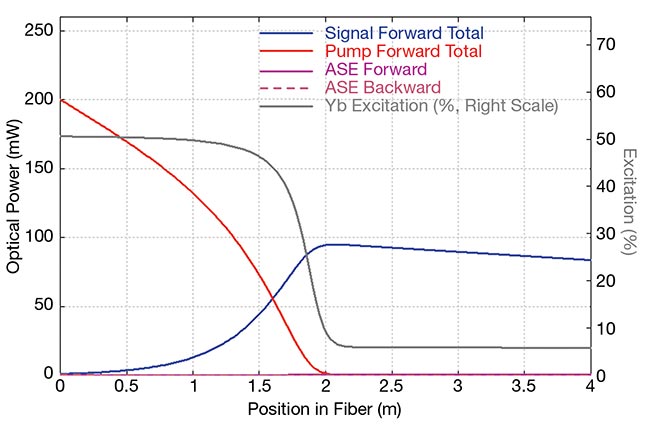
Figure 2. A 1-mW input signal at 1030 nm is injected and the signal is amplified to nearly 100 mW. Gain saturation effects determine that the substantially excited portion of the
fiber shortens. ASE: amplified spontaneous emission. Courtesy of RP Photonics.
As depicted in Figure 2, halving the length of the fiber would improve the performance. Also, with the gain now reduced, the ASE is largely suppressed.
From these systems, it is evident that the detailed behavior of a rare-earth doped fiber may differ greatly from initial expectations, since it is hard to anticipate all relevant details of the physics that are involved. Therefore, optimizing an amplifier or laser design without simulations is difficult — even in simple situations. The prospects to ensure optimal results decrease when a design calls for a more sophisticated setup, such as with multiple gain stages, ASE filtering between the stages, pulse amplification, and/or when a spectrally flat gain is required.
Dynamic behavior
The upper-state lifetimes of rare-earth ions are quite long compared to various other laser-active ions. They are ~1 ms for Yb and slightly <10 ms for Er. These values are somewhat dependent on the fiber glass composition.
Therefore, when placed into a system,
the amplifier gain builds up for a considerable time after the pump source is turned on. Also, it does not saturate immediately upon signal injection.
The amplifier gain is related to a substantial amount of excitation energy stored in the fiber. This can be exploited for pulse amplification. In fact, it is often possible to extract a substantial part of that energy with only a single pulse. This happens in the case of pulse energies that are above the given saturation energy — sometimes even in the range of tens of millijoules. During pulse amplification, the gain drops off sharply, distorting the temporal pulse shape.
For example, in Figure 3, the same
Yb-doped single-mode fiber is pumped for 1.5 ms and then injected with a
Gaussian 5-µJ signal pulse (1030 nm). Since the output pulse energy is 96 µJ, a value that is well above the saturation energy, the system experiences strong pulse distortion.
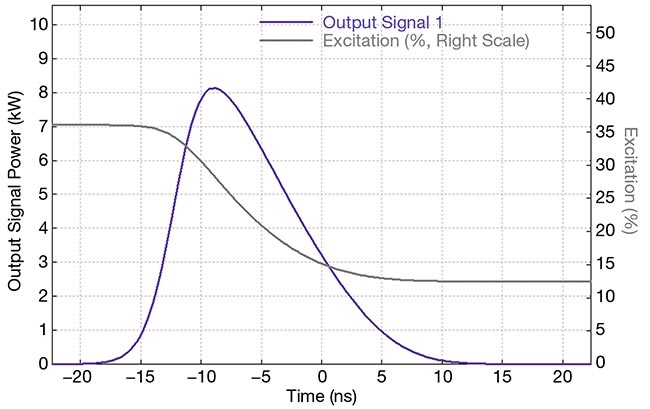
Figure 3. A signal output pulse of the amplifier. The input pulse is Gaussian, centered at t = 0. With the output pulse energy beyond the saturation energy, the system experiences strong pulse distortion. Courtesy of RP Photonics.
In this sequence, it is worth mentioning that the power amplification factor depends exponentially on the average excitation and, as a result, drops significantly during the pulse. Figure 4 shows the state of the amplifier before and after the pulse amplification. Indeed, the Yb excitation drops sharply, which also causes a sudden increase in the pump absorption and a much faster decline of the pump power after the pulse. After this takes place, the pump source would again require on the order of 1 ms to return to a well-pumped state. Also, complete energy extraction is mainly prevented by signal reabsorption; this effect would be weaker for longer wavelengths of the pulse.
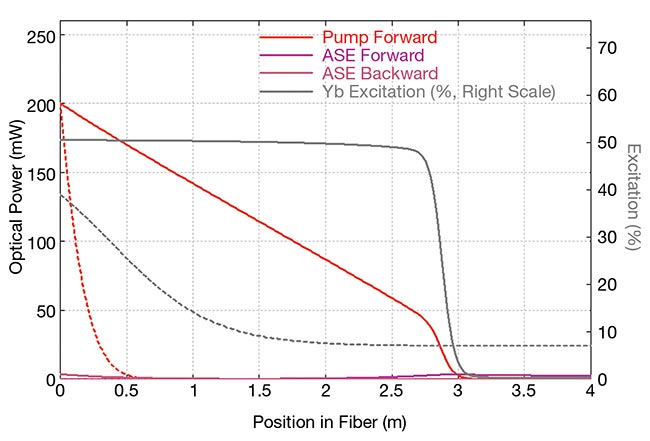
Figure 4. The state of the fiber amplifier before and after pulse amplification. The ytterbium (Yb) excitation drop causes the pump absorption to experience a sudden increase, or a much faster decline of the pump power after the pulse. ASE: amplified spontaneous emission. Courtesy of RP Photonics.
This system assumes an input pulse duration of 10 ns, which results in a peak output power of 8.1 kW. This level of power causes a degree of nonlinear
broadening of the optical spectrum. Nonlinear limitations intensify substantially in the case of picosecond or even femtosecond pulses.
Fiber compositions
The distinct chemical compositions of rare-earth doped fibers can affect aspects of performance. Properties such as doping density, wavelength-dependent transition
cross sections of the rare-earth ions, as well as their tendency to cluster and degrade performance, for example, are relevant and can be revealed with spectroscopic measurements. Further, chemical composition can influence a tendency for photodarkening of Yb-doped fibers, for example, thereby causing the fiber to progressively degrade.
The compositions of most rare-earth doped fibers are based on fused silica with various additives. These may include germanium, which can be used to increase refractive index control; the rare-earth ions of Yb, Er, neodymium (Nd), and/or Tm; and, often, other ions, such as aluminum, the addition of which improves the solubility of the rare-earth materials.
In some cases, two different rare-earth ions are used in combination. The most common example involves ions of Yb and Er. The Er ions serve as the laser-active ion, while the Yb ions, which are used with a much higher doping density, ensure the efficient absorption of the pump radiation. The Yb ions transfer their excitation energy efficiently to Er, provided that the fiber composition is optimized. Using only a higher density of Er alone will not deliver an optimal result due to clustering and signal reabsorption issues.
Other applications require the use of non-silica glasses. For example, heavy metal fluoride glasses enable much longer lifetimes of certain excited levels of rare-earth ions because they have lower phonon energies. Such fibers enable the use of different amplifiers or laser transitions that would be completely bypassed by fast nonradiative decay processes (involving multiphonon emission) in silica-based glasses. Today, fluoride glasses are limited to a handful of niche applications such as upconversion lasers and mid-infrared amplifiers, since they are expensive to manufacture, much less mechanically robust than silica glasses, and, as a result, comparatively more difficult to handle — such as for cleaving and splicing.
Large mode area fibers
Especially in amplifiers for intense light pulses, fiber nonlinearities are often the critical performance-limiting factor. To some extent, increasing the effective mode area can mitigate this bottleneck. Although it is easy to increase the diameter of the fiber core, most users must typically ensure that the fiber retains single-mode performance to easily maintain high output beam quality.
There are some trade-offs to consider in these matters: Reducing the refractive index contrast, or the numerical aperture (NA) of the fiber, for example, is a straightforward way to increase mode area. But this action results in less robust light guiding and ultimately makes the fiber overly sensitive to micro- and macro-bending losses as well as manufacturing imperfections. For rare-earth doped fibers, this challenge is even greater than for passive fibers since the cores of these fibers tend to exhibit larger refractive index fluctuations.
Additional methods to achieve large mode areas include those that relate to photonic crystal fibers, where the trade-off between mode area and light guiding robustness can be mitigated more effectively than with other fiber types.
Still, a large mode area naturally implies less robust guiding. With a weak effect of diffraction, which must be compensated by a correspondingly weak focusing effect based on the fiber design, the mode that forms by balancing the two weak, counteracting effects is naturally sensitive to additional, often undesirable influences, such as bending.
Double- and triple-clad fibers
The injection of pump light poses another set of challenges for high-power lasers and amplifiers. Because it is physically impossible to inject pump light of poor beam quality (for example, from a diode bar) into a single-mode or few-mode fiber core in an efficient way, double-clad fiber designs are needed. Here, most of the pump light is injected into a pump cladding that is much larger in diameter than the core. This pump cladding can also have a much larger NA. Therefore, it can support many guided modes, making it suitable even for pump sources with poor beam quality.
A simple double-clad design is radially symmetric, with a circular core inside a circular pump cladding. Unfortunately, this architecture suffers from low pump absorption for a substantial part of the pump cladding modes because it features little spatial overlap with the core. A
common remedy involves reducing the symmetry, for example, by using a D-shaped or octagonal pump cladding. In addition, a user can apply a degree of controlled bending of the fiber, which introduces mode mixing.
Double-clad fiber designs often have a polymer coating as the outer boundary of the pump cladding. Such a fiber is simple to fabricate and features a high refractive
index contrast, resulting in a high NA of the pump cladding. However, it is problematic to expose the polymer to high pump intensities and high temperatures.
A triple-clad design, in which an addi-
tional glass cladding around the pump cladding confines the light and the
polymer coating no longer fulfills any optical function, is the preferred design for extreme operation regimes. The triple-clad approach also allows designers to realize substantially smaller pump claddings. A lower area ratio between pump cladding and core benefits system performance for certain applications.
It is most common to use a double-clad
design with a standard 125-µm pump cladding diameter. This leads to a relatively large area ratio, typically of the order of 100, which has important implications for performance.
Figure 5 considers the same Yb-doped fiber, with the same Yb concentration in the core, but now with the core surrounded by a 125-µm pump cladding. We apply 20-W pump power at 975 nm, moving backward. Now, 30 m of fiber is needed to obtain reasonably efficient pump absorption. This increase in fiber length is much smaller than expected from the area ratio, because there is now a lower degree of saturation of pump absorption. And the Yb excitation is higher near the input end even though the pump power is quite low. Because the signal is much more strongly coupled to the Yb in the fiber core, the signal power is much more relevant for the degree of Yb excitation. The same holds for ASE, which keeps the Yb excitation low in the first 2 m.
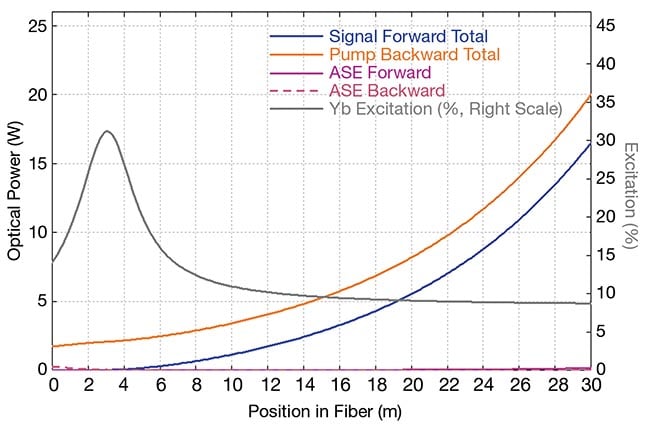
Figure 5. Powers and ytterbium (Yb) excitation in a backward-pumped (orange) double-clad (125-µm) fiber. The double-clad design establishes a relatively large area ratio, which has important implications on system performance. ASE: amplified spontaneous emission. Courtesy of RP Photonics.
To support pumping at 940 nm, for example, a much longer fiber would be needed, or, alternatively, a higher Yb density if a larger core alone would not be sufficient. With more Yb in the fiber, the reabsorption at the 1030 nm signal wavelength would be correspondingly stronger. The maximum effective gain then shifts to longer wavelengths. For this reason, Yb-doped double-clad fibers are often used for amplification in the longer-wavelength region, which unfortunately increases the quantum defect. Nevertheless, the power conversion efficiency can easily exceed 80%.
Fiber characterization
For rare-earth doped and specialty fibers, it is highly desirable that the manufacturer specifies all relevant parameters, because this information makes the fiber performance predictable. With simulation software, users (or their consultants) can then work out amplifier and laser designs before purchasing components. As experienced system designers and end users know, analyzing and solving all varieties of problems based on lab experiments can be tedious, time-consuming, and expensive, since failure to achieve the desired performance often does not indicate the underlying problem and its solution.
While waveguide parameters of the fibers are typically well known, the spectroscopic details are not so easy to determine. This is especially true in more complicated cases, such as when energy transfer between ions or excited state absorption is relevant. Certain important quantities cannot be measured directly, but one can use simulation models to fit spectroscopic parameters to available data.
So, if manufacturers invest in comprehensive fiber characterization, they can market fibers with predictable performance. This enables customers to achieve
success without many optimization steps.
For relatively standard fibers, for
example, doped with ions of Yb, Er, or Nd, suppliers often deliver relatively comprehensive and reliable spectroscopic data, at least for use with the common pump and amplification transitions. For more specialized fibers and use cases, however, users often must measure certain fiber parameters themselves, or accept substantially more iterations until they achieve optimized device designs.
Efficient development of fiber devices
Forty years after their arrival, the principles of rare-earth doped fibers are comprehensively understood. This is vital to their continued wide use, since a deep qualitative and quantitative understanding is essential to the efficient development of fiber amplifiers and lasers. Pure intuition based on simple pictures will often fail due to complications introduced by strong pump and gain saturation, signal reabsorption, and ASE, for example. In many cases, with fiber data obtained from the manufacturer and suitable simulation software, designers and users can reliably predict the performance of rare-earth doped fibers and thus avoid purchasing and testing of fibers that, in the end, may not yield satisfactory results.